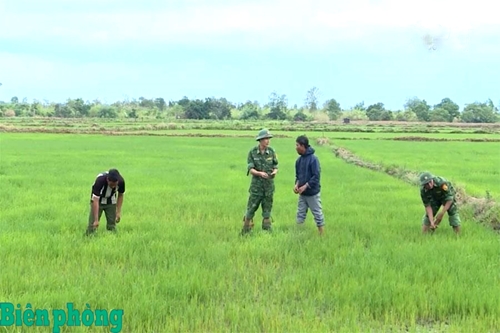Gia Lai, located in Vietnam’s Central Highlands region, is a land rich in revolutionary traditions. It serves as a vital economic, cultural, and social gateway, connecting the Central Coastal provinces, the Southeastern region of Vietnam, and neighboring countries within the Vietnam-Laos-Cambodia Development Triangle. Home to diverse ethnic groups, Gia Lai is imbued with a vibrant and distinctive cultural identity. Through the flow of history, the province has cultivated enduring values and now stands at the threshold of sustainable development.
    |
 |
|
Border troops instruct local people to grow wet rice. (Photo: bienphong.com.vn) |
In Ring border village, Ia Mo commune, Chu Prong district, the atmosphere is filled with the bustle of hard work. Founded in 2005 by young volunteers from various provinces seeking to develop the local economy, the village is now thriving. Across the fields, people are busy tilling the land, planting crops, and preparing for the upcoming season.
Nguyen Van Toan, the village’s Party Cell Secretary and one of its first settlers, recalled that when they joined the resettlement project, each person was allocated 1,000 square meters of residential land, 1,440 square meters of rice paddies, and 1.8 hectares of farmland. From the beginning, they were determined to protect the nation’s borders. They also considered this place their new home and committed themselves to building it together.
Today, many households in Ring village enjoy stable incomes. Some have built new houses, others own cars or have escaped poverty through hard work—like Deputy Party Secretary Dam Thi Ninh, a capable and diligent woman. She and her husband have built an enviable life over 20 years of settling in the area. “Moving here was the right decision,” she shared. “If I had to choose again, I would still follow the Party’s call. No regrets at all.”
Ring village, once isolated and underdeveloped, has now become a bright spot in the border region. With spacious houses, lush fields, and a bustling agricultural trade linking it to Ea H’leo district in Dak Lak province, the area has undergone a remarkable transformation.
Unlike Ring village, the Suoi Khon settlement had long struggled with administrative challenges. Formed by Jrai ethnic households from Ia Pia commune practicing shifting cultivation, the local people lived on land technically part of Ia Mo commune, which made population management difficult. In March 2022, Gia Lai’s provincial authorities officially recognized Suoi Khon as a hamlet of Ia Mo commune, helping over 100 households stabilize their lives. This recognition paved the way for infrastructure development and a more sustainable future in the border area.
Standing side by side with the border residents are the dedicated soldiers from the Ia Lop Border Post under the Gia Lai Provincial Border Guard Command. These troops live among the locals, helping them develop long-term agricultural models such as wet rice cultivation. They have become a strong pillar of support, helping local people place trust in the Party’s guidelines and build a better life. The soldiers also actively promote awareness of the Party’s guidelines and the State’s policies and laws.
Accompanying the border troops are the local people, who are regarded as “living landmarks.”
The roads leading to Ring and Suoi Khon bear the footprints of the border troops. The Ia Lop Border Post maintains two working teams, comprising officers, Party members, and military medical staff who live and work in the area. Their support has contributed significantly to addressing local issues such as public security, healthcare, and disaster recovery.
Today, Ring and Suoi Khon are second homes for many young people and households who have chosen these lands to start a new life.
Source: Baobienphong
Translated by Minh Anh